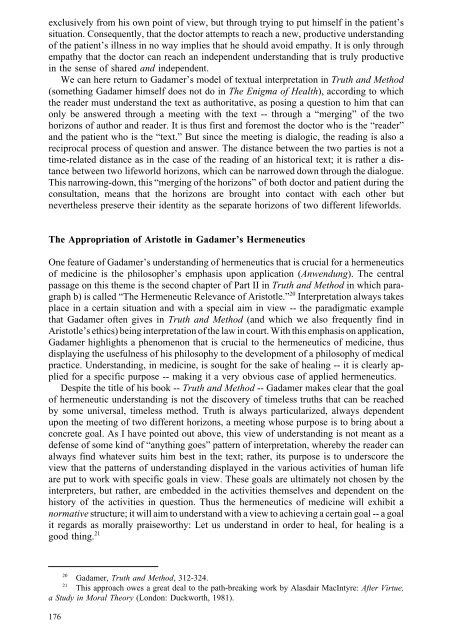[Andrzej_Wiercinski_(ed ... - WordPress.com
[Andrzej_Wiercinski_(ed ... - WordPress.com
[Andrzej_Wiercinski_(ed ... - WordPress.com
Create successful ePaper yourself
Turn your PDF publications into a flip-book with our unique Google optimized e-Paper software.
exclusively from his own point of view, but through trying to put himself in the patient’ssituation. Consequently, that the doctor attempts to reach a new, productive understandingof the patient’s illness in no way implies that he should avoid empathy. It is only throughempathy that the doctor can reach an independent understanding that is truly productivein the sense of shar<strong>ed</strong> and independent.We can here return to Gadamer’s model of textual interpretation in Truth and Method(something Gadamer himself does not do in The Enigma of Health), according to whichthe reader must understand the text as authoritative, as posing a question to him that canonly be answer<strong>ed</strong> through a meeting with the text -- through a “merging” of the twohorizons of author and reader. It is thus first and foremost the doctor who is the “reader”and the patient who is the “text.” But since the meeting is dialogic, the reading is also areciprocal process of question and answer. The distance between the two parties is not atime-relat<strong>ed</strong> distance as in the case of the reading of an historical text; it is rather a distancebetween two lifeworld horizons, which can be narrow<strong>ed</strong> down through the dialogue.This narrowing-down, this “merging of the horizons” of both doctor and patient during theconsultation, means that the horizons are brought into contact with each other butnevertheless preserve their identity as the separate horizons of two different lifeworlds.The Appropriation of Aristotle in Gadamer’s HermeneuticsOne feature of Gadamer’s understanding of hermeneutics that is crucial for a hermeneuticsof m<strong>ed</strong>icine is the philosopher’s emphasis upon application (Anwendung). The centralpassage on this theme is the second chapter of Part II in Truth and Method in which paragraphb) is call<strong>ed</strong> “The Hermeneutic Relevance of Aristotle.” 20 Interpretation always takesplace in a certain situation and with a special aim in view -- the paradigmatic examplethat Gadamer often gives in Truth and Method (and which we also frequently find inAristotle’s ethics) being interpretation of the law in court. With this emphasis on application,Gadamer highlights a phenomenon that is crucial to the hermeneutics of m<strong>ed</strong>icine, thusdisplaying the usefulness of his philosophy to the development of a philosophy of m<strong>ed</strong>icalpractice. Understanding, in m<strong>ed</strong>icine, is sought for the sake of healing -- it is clearly appli<strong>ed</strong>for a specific purpose -- making it a very obvious case of appli<strong>ed</strong> hermeneutics.Despite the title of his book -- Truth and Method -- Gadamer makes clear that the goalof hermeneutic understanding is not the discovery of timeless truths that can be reach<strong>ed</strong>by some universal, timeless method. Truth is always particulariz<strong>ed</strong>, always dependentupon the meeting of two different horizons, a meeting whose purpose is to bring about aconcrete goal. As I have point<strong>ed</strong> out above, this view of understanding is not meant as adefense of some kind of “anything goes” pattern of interpretation, whereby the reader canalways find whatever suits him best in the text; rather, its purpose is to underscore theview that the patterns of understanding display<strong>ed</strong> in the various activities of human lifeare put to work with specific goals in view. These goals are ultimately not chosen by theinterpreters, but rather, are emb<strong>ed</strong>d<strong>ed</strong> in the activities themselves and dependent on thehistory of the activities in question. Thus the hermeneutics of m<strong>ed</strong>icine will exhibit anormative structure; it will aim to understand with a view to achieving a certain goal -- a goalit regards as morally praiseworthy: Let us understand in order to heal, for healing is agood thing. 2120Gadamer, Truth and Method, 312-324.21This approach owes a great deal to the path-breaking work by Alasdair MacIntyre: After Virtue,a Study in Moral Theory (London: Duckworth, 1981).176


